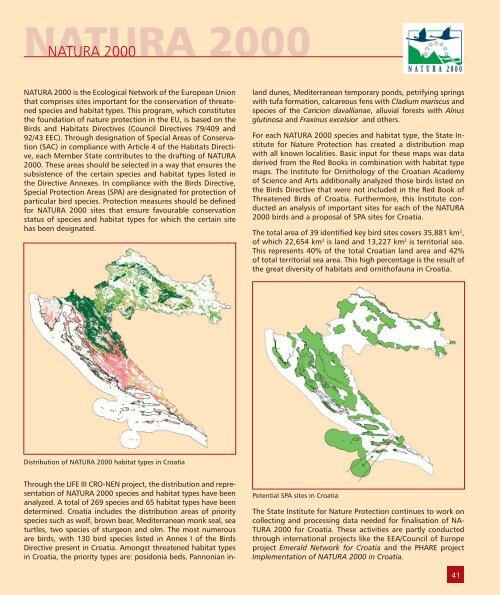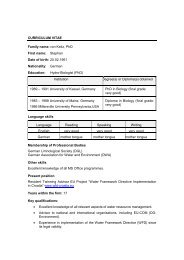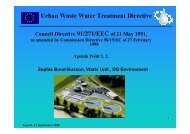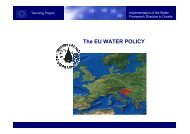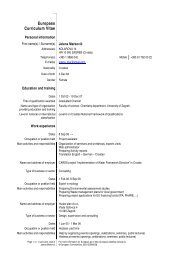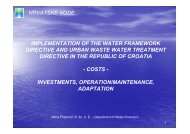BIODIVERSITY OF CROATIA
BIODIVERSITY OF CROATIA
BIODIVERSITY OF CROATIA
Create successful ePaper yourself
Turn your PDF publications into a flip-book with our unique Google optimized e-Paper software.
2000<br />
NATURA 2000<br />
NATURA 2000 is the Ecological Network of the European Union<br />
that comprises sites important for the conservation of threatened<br />
species and habitat types. This program, which constitutes<br />
the foundation of nature protection in the EU, is based on the<br />
Birds and Habitats Directives (Council Directives 79/409 and<br />
92/43 EEC). Through designation of Special Areas of Conservation<br />
(SAC) in compliance with Article 4 of the Habitats Directive,<br />
each Member State contributes to the drafting of NATURA<br />
2000. These areas should be selected in a way that ensures the<br />
subsistence of the certain species and habitat types listed in<br />
the Directive Annexes. In compliance with the Birds Directive,<br />
Special Protection Areas (SPA) are designated for protection of<br />
particular bird species. Protection measures should be defined<br />
for NATURA 2000 sites that ensure favourable conservation<br />
status of species and habitat types for which the certain site<br />
has been designated.<br />
land dunes, Mediterranean temporary ponds, petrifying springs<br />
with tufa formation, calcareous fens with Cladium mariscus and<br />
species of the Caricion davallianae, alluvial forests with Alnus<br />
glutinosa and Fraxinus excelsior and others.<br />
For each NATURA 2000 species and habitat type, the State Institute<br />
for Nature Protection has created a distribution map<br />
with all known localities. Basic input for these maps was data<br />
derived from the Red Books in combination with habitat type<br />
maps. The Institute for Ornithology of the Croatian Academy<br />
of Science and Arts additionally analyzed those birds listed on<br />
the Birds Directive that were not included in the Red Book of<br />
Threatened Birds of Croatia. Furthermore, this Institute conducted<br />
an analysis of important sites for each of the NATURA<br />
2000 birds and a proposal of SPA sites for Croatia.<br />
The total area of 39 identified key bird sites covers 35,881 km 2 ,<br />
of which 22,654 km 2 is land and 13,227 km 2 is territorial sea.<br />
This represents 40% of the total Croatian land area and 42%<br />
of total territorial sea area. This high percentage is the result of<br />
the great diversity of habitats and ornithofauna in Croatia.<br />
Distribution of NATURA 2000 habitat types in Croatia<br />
Through the LIFE III CRO-NEN project, the distribution and representation<br />
of NATURA 2000 species and habitat types have been<br />
analyzed. A total of 269 species and 65 habitat types have been<br />
determined. Croatia includes the distribution areas of priority<br />
species such as wolf, brown bear, Mediterranean monk seal, sea<br />
turtles, two species of sturgeon and olm. The most numerous<br />
are birds, with 130 bird species listed in Annex I of the Birds<br />
Directive present in Croatia. Amongst threatened habitat types<br />
in Croatia, the priority types are: posidonia beds, Pannonian in-<br />
Potential SPA sites in Croatia<br />
The State Institute for Nature Protection continues to work on<br />
collecting and processing data needed for finalisation of NA-<br />
TURA 2000 for Croatia. These activities are partly conducted<br />
through international projects like the EEA/Council of Europe<br />
project Emerald Network for Croatia and the PHARE project<br />
Implementation of NATURA 2000 in Croatia.<br />
41


